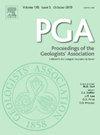EECO对哺乳动物群的影响:来自法国蒙彼利埃的新埃及地区,多学科方法
IF 1.2
4区 地球科学
Q2 Earth and Planetary Sciences
引用次数: 0
摘要
对法国南部蒙彼利埃北部一个新的陆相沉积序列进行了综合年代学研究,发现其年龄在52.1 ~ 49.7 Ma之间。该序列包含本研究首次描述的三个新的哺乳动物化石位置,并与附近的Mas de Gimel (MP10 -欧洲哺乳动物古近系参考尺度[MP])特别丰富的遗址相关联。这项研究限制了Grauvian ELMA(欧洲陆地哺乳动物时代)在地质时间尺度上的年龄,表明它与EECO(早始新世气候最佳期)比以前认为的更接近,特别是与高振幅气候波动时期。这些新的动物群和数据使我们能够讨论欧洲哺乳动物古近系参考尺度[MP]的相关性,并为晚伊波斯提出新的大陆生物带。研究还表明,晚期Neustrian动物群(MP8 + 9)与EECO的发生是同时代的,在法国南部可能存在几个晚期和后EECO动物群。此外,我们的研究还表明,正如在北美观察到的那样,在温暖时期有多样化的阶段,在寒冷时期有灭绝的阶段。未来对这一关键时期欧洲化石地点的精确测年将有助于在进一步的洲际比较的框架内讨论全球变暖对哺乳动物群落的影响。本文章由计算机程序翻译,如有差异,请以英文原文为准。
Impact of the EECO on mammalian faunas: New Ypresian localities from Montpellier (France), a multidisciplinary approach
An integrative chronological study on a new terrestrial sedimentary sequence north of Montpellier (southern France) yields an age ranging from 52.1 to 49.7 Ma. This sequence contains three new mammalian fossil localities, for the first time described in this study, and is associated with the nearby specifically rich site of Mas de Gimel (MP10 — European Mammalian Paleogene Reference Scale [MP]). This study constrains the age of the Grauvian ELMA [European Land Mammal Age] with respect to the geological time scale, suggesting that it is more contemporary with the EECO (Early Eocene Climatic Optimum) than previously considered, and in particular with the period of High Amplitude Climate Fluctuations. These new faunas and data allow us to discuss the relevance of the European Mammalian Paleogene Reference Scale [MP] and to propose new continental biozones for the late Ypresian. It also demonstrates that the late Neustrian fauna (MP8 + 9) is contemporary with the onset of the EECO and that there may be several late- and post-EECO faunas in southern France. Our study moreover suggests phases of diversification during the warm periods, and extinction during the cooling, as observed in North America. Future refined dating of the European fossil localities of this key period will help to discuss the impact of global warming on mammalian communities in the frame of further intercontinental comparisons.
求助全文
通过发布文献求助,成功后即可免费获取论文全文。
去求助
来源期刊
CiteScore
2.70
自引率
8.30%
发文量
54
审稿时长
6-12 weeks
期刊介绍:
The Proceedings of the Geologists'' Association is an international geoscience journal that was founded in 1859 and publishes research and review papers on all aspects of Earth Science. In particular, papers will focus on the geology of northwestern Europe and the Mediterranean, including both the onshore and offshore record. Following a long tradition, the PGA will focus on: i) a range of article types (see below) on topics of wide relevance to Earth Sciences ii) papers on aspects of Earth Science that have societal relevance including geoconservation and Earth management, iii) papers on palaeoenvironments and palaeontology of the Mesozoic and Cenozoic, iv) papers on aspects of Quaternary geology and climate change, and v) papers on the history of geology with particular reference to individuals that have shaped the subject. These topics will also steer the content of the themes of the Special Issues that are published in the PGA.

 求助内容:
求助内容: 应助结果提醒方式:
应助结果提醒方式:


